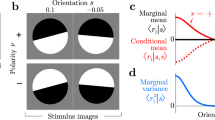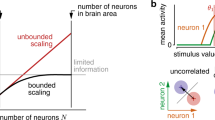Abstract
The population vector code relates directional tuning of single cells and global, directional motion incited by an assembly of neurons. In this paper three things are done. First, we analyze the population vector code as a purely geometric construct, focusing attention on its universality. Second, we generalize the algorithm on the basis of its geometrical realization so that the same construct that responds to sensation can function as an actuator for behavioral output. Third, we suggest at least a partial answer to the question of what many maps, neuronal representations of the outside sensory world in space–time, are good for: encoding vectorial input they enable a direct realization of the population vector code.
Similar content being viewed by others
References
Abbott LF (1994) Decoding neuronal firing and modelling neural networks. Q Rev Biophys 27: 291–31
Averbeck BB, Latham PE, Pouget A (2006) Neural correlations, population coding, and computation. Nat Neurosci 6: 358–66
Barth FG (ed) (1985) Neurobiology of arachnids. Springer, Berlin
Bergenheim M, Ribot-Ciscar E, Roll JP (2000) Proprioceptive population coding of two-dimensional limb movements in humans: I. Muscle spindle feedback during spatially oriented movements. Exp Brain Res 134: 301–10
Bosco G, Poppele RE (1993) Broad directional tuning in spinal projections to the cerebellum. J Neurophysiol 70: 863–66
Brand A, Behrend O, Marquardt T, McAlpine D, Grothe B (2002) Precise inhibition is essential for microsecond interaural time difference coding. Nature 417: 543–47
Brownell PH (1977) Compressional and surface waves in sand: used by desert scorpions to locate prey. Science 1977: 479–82
Brownell PH (1984) Prey detection by the sand scorpion. Sci Am 251(6): 94–05
Brownell PH, Farley RD (1979) Detection of vibrations in sand by tarsal sense organs of the nocturnal scorpion Paruroctonus mesaensis. J Comp Physiol 131:23–0; Orientation to vibrations in sand by the nocturnal scorpion Paruroctonus mesaensis: mechanism of target localization. J Comp Physiol 131:31–8
Brownell PH, van Hemmen JL (2001) Vibration sensitivity and a computational theory for prey-localizing behavior in sand scorpions. Am Zool 41(5): 1229–240
Brownell PH, Polis G (eds) (2001) Scorpion biology and research. Oxford University Press, Oxford
Georgopoulos AP, Kalaska JF, Caminiti R, Massey JT (1982) On the relations between the direction of two-dimensional arm movements and cell discharge in primate motor cortex. J Neurosci 2: 1527–537
Georgopoulos AP, Caminiti R, Kalaska JF, Massey JT (1983) Spatial coding of movement: a hypothesis concerning the coding of movement direction by motor cortical populations. Exp Brain Res Suppl 7: 327–36
Georgopoulos AP, Kalaska JF, Crutcher MD, Caminiti R, Massey JT (1984) The representation of movement direction in the motor cortex: single cell and population studies. In: Edelman GM, Goll WE, Cowan WM(eds) Dynamic aspects of neocortical function. Neurosciences Research Foundation, New York, pp 501–24
Georgopoulos AP, Kettner RE, Schwartz AB (1988) Primate motor cortex and free arm movements to visual targets in three-dimensional space. II. Coding of the direction of movement by a neuronal population. J Neurosci 8: 2928–937
Georgopoulos AP, Schwartz AB, Kettner RE (1986) Neuronal population coding of movement direction. Science 233: 1416–419
Gerstner W, Kempter R, van Hemmen JL, Wagner H (1996) A neuronal learning rule for sub-millisecond temporal coding. Nature 383: 76–8
Hebb DO (1949) The organization of behavior. Wiley, New York
Helms Tillery SI, Flanders M, Soechting JF (1991) A coordinate system for the synthesis of visual and kinesthetic information. J Neurosci 11: 770–78
van Hemmen JL (2001) Theory of synaptic plasticity. In: Moss F, Gielen S(eds) Handbook of biological physics, vol 4: neuro-informatics, neural modelling. Elsevier, Amsterdam, pp 771–23
van Hemmen JL (2006) What is a neuronal map, how does it arise, and what is it good for? In: van Hemmen and Sejnowski (2006), pp 83–02
van Hemmen JL (2007) Biology and mathematics: a fruitful merger of two cultures. Biol Cybern 97: 1–
van Hemmen JL (2006) What is a neuronal map, how does it arise, and what is it good for? In: van Hemmen and Sejnowski (2006), pp 83–02
Johnson MT, Ebner TJ (2000) Processing of multiple kinematic signals in the cerebellum and motor cortices. Brain Res Rev 33: 155–68
Kalaska JF, Caminiti R, Georgopoulos AP (1983) Cortical mechanisms related to the direction of two-dimensional arm movements: relations in parietal area 5 and comparison with motor cortex. Exp Brain Res 51: 247–60
Kapfer C, Seidl AH, Schweizer H, Grothe B (2002) Experience-dependent refinement of inhibitory inputs to auditory coincidence-detector neurons. Nat Neurosci 5: 247–53
Kempter R, Leibold C, Wagner H, van Hemmen JL (2001) Formation of temporal feature maps by axonal propagation of synaptic learning. Proc Natl Acad Sci USA 98: 4166–171
Konishi M (1993) Listening with two ears. Sci Am 268(4): 34–1
Konishi M (2003) Coding of auditory space. Annu Rev Neurosci 26: 31–5
Kristan WB Jr, Shaw BK (1997) Population coding and behavioral choice. Curr Opin Neurobiol 7: 826–31
Kutz DF, Dannenberg W, Werner W, Hoffmann K-P (1997) Population coding of arm-movement-related neurons in and below the superior colliculus of Macaca mulatta. Biol Cybern 76: 331–37
Lang HH (1980) Surface wave sensitivity of the back swimmer Notonecta glauca. Naturw 67: 204–05
Leibold C, van Hemmen JL (2002) Mapping time. Biol Cybern 87: 428–39
Leibold C, van Hemmen JL (2005) Spiking neurons learning phase delays: how mammals may develop auditory time-difference sensitivity. Phys Rev Lett 94: 168102
Lewis JE (1999) Sensory processing and the network mechanisms for reading neuronal population codes. J Comp Physiol A 185: 373–78
McAlpine D, Grothe B (2003) Sound localization and delay lines—do mammals fit the model?. Trends Neurosci 26: 347–50
Murphey RK, Mendenhall B (1973) Localization of receptors controlling orientation to prey by the back swimmer Notonecta undulata. J Comp Physiol A 84: 19–0
Murphey RK (1973) Mutual inhibition and the organization of a non-visual orientation in Notonecta. J Comp Physiol A 84: 31–0
Motter BC, Steinmetz MA, Duffy CJ, Mountcastle VB (1987) Functional properties of parietal visual neurons: mechanisms of directionality along a single axis. J Neurosci 7: 154–76
Mountcastle VB (1998) The cerebral cortex. Harvard University Press, Cambridge
Pellionisz A (1988) Tensorial aspects of the multidimensional massively parallel sensorimotor function of neuronal networks. In: Pompeiano O, Allum JHJ(eds) Progress in brain research, vol 76. Elsevier, Amsterdam, pp 341–54
Press WH, Teukolsky SA, Vetterling WT, Flannery BP (2007) Numerical recipes, 3rd edn. Cambridge University Press, Cambridge
Reina GA, Moran DW, Schwartz AB (2001) On the relationship between joint angular velocity and motor cortical discharge during reaching. J Neurophysiol 85: 2576–589
Salinas E, Abbott LF (1994) Vector reconstruction from firing rates. J Comput Neurosci 1: 89ndash;107
Schwartz AB (1992) Motor cortical activity during drawing movements: single-unit activity during sinusoid tracing. J Neurophysiol 68: 528–41
Schwartz AB (1994) Direct cortical representation of drawing. Science 265: 540–42
Schwartz AB (2007) Useful signals from motor cortex. J Physiol 579: 581–01
Schwartz AB, Kettner RE, Georgopoulos AP (1988) Primate motor cortex and free arm movements to visual targets in three-dimensional space. I. Relations between single cell discharge and direction of movement. J Neurosci 8: 2913–927
Seung HS, Sompolinsky H (1993) Simple models for reading neuronal population codes. Proc Natl Acad Sci USA 90: 10749–0753
Soechting JF (1989) Elements of coordinated arm movements in three-dimensional space. In: Wallace SA(eds) Perspectives on the coordination of Movement. North-Holland, Amsterdam, pp 47–3
Soechting JF, Flanders M (1991a) Arm movements in 3-dimensional space: Computation, theory, and observation. Exerc Sports Sci Rev 19: 389–18
Soechting JF, Flanders M (1991b) Deducing central algorithms of arm movement control from kinematics. In: Humphrey DR, Freund H-J(eds) Motor control: concepts and issues. Wiley, New York, pp 293–06
Stürzl W, Kempter R, van Hemmen JL (2000) Theory of arachnid prey localization. Phys Rev Lett 84: 5668–671
Taylor DM, Helms Tillery SI, Schwartz AB (2002) Direct cortical control of 3D neuroprosthetic devices. Science 296: 1829–832
Turner RS, Anderson ME (1997) Pallidal discharge related to the kinematics of reaching movements in two dimensions. J Neurophysiol 77: 1051–074
Weber DJ, Stein RB, Everaert DG, Prochazka A (2006) Decoding sensory feedback from firing rates of afferent ensembles recorded in cat dorsal root ganglia in normal locomotion. IEEE Trans Neural Syst Rehabil Eng 14: 240–43
Zhang K, Sejnowski TJ (1999) Neuronal tuning: to sharpen or broaden?. Neural Comp NC 11: 75–4
Author information
Authors and Affiliations
Corresponding author
Rights and permissions
About this article
Cite this article
van Hemmen, J.L., Schwartz, A.B. Population vector code: a geometric universal as actuator. Biol Cybern 98, 509–518 (2008). https://doi.org/10.1007/s00422-008-0215-3
Received:
Accepted:
Published:
Issue Date:
DOI: https://doi.org/10.1007/s00422-008-0215-3




